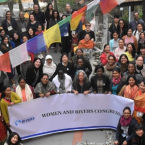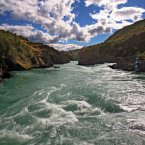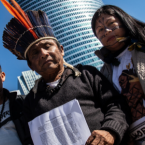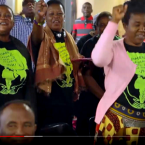2019 Impact Statement: A Voice for Rivers Under Threat
The future of our waterways is uncertain as ever. As climate change escalates the frequency and scale of extreme weather events, wreaking havoc on some of our world’s most vital and life-sustaining ecosystems already threatened by profit-driven destructive development – the rivers that give these places life are often the first places where the harm is most acutely felt. From the conversion of freshwater sources for drinking and agriculture into methane-emitting reservoirs, to the loss of fisheries and farms that sustain local livelihoods and thereby indigenous cultures and languages, to the systematic reduction of the immensely biodiverse freshwater life that depend on rivers – the future of our water hangs in precarious balance.
What’s not uncertain is the resilience of people’s movements for the protection of our rivers and waterways. In the face of a global trend of rollbacks on environmental protections and persecution of environmental and human rights defenders, a network of river defenders continues to grow. Through globally-connected local action, we articulate our shared vision for a world in which rivers are protected as the life-giving arteries of the Earth that they are, in which truly clean energy solutions are locally owned and accessed, and in which the rights of local and indigenous river stewards and defenders are respected.
Women are often at the heart of these local movements. Despite being excluded from decision-making tables from the local level to transnational spaces that are dominated by men – women are primary stewards and defenders of freshwater. At the first Women and Rivers Congress in March 2019, we heard countless stories of women who fought for their voices to be heard as they spoke up for clean water, of women who banned together to block the intrusion of male-led workforces that had come to develop projects on their rivers, of women who are creating locally-owned energy projects, and of women who have spent their lives engaged in research on the governance and management of rivers.
For three days, we shared our common struggles as well as strategic tools and concepts. We emerged with a collective commitment – to continue our fight to protect free-flowing rivers and the lands, forests and territories they sustain, to ensure women’s leadership in decision-making at all levels over freshwater resources, and to strengthen and build alliances and grow our movement, for the future of ourselves as women, our families and communities, our rivers and our planet.
At International Rivers, it is the fearlessness and innovative-thinking of river defenders like those at the Women and Rivers Congress that give us hope. As you’ll see in the highlights below, 2019 marked a milestone year for our staff involved in the global call for permanent river protection, and saw our continued advocacy for accountability of some of the world’s largest corporate actors that are impacting rivers. International Rivers currently has 24 staff critically engaged in movements to protect dozens of critical river basins, with particular focus on the Amazonian rivers of Brazil, Peru, and Colombia, Chile’s Patagonia, Southeast Asia’s Mekong and Salween, and DRC’s Congo River.
Leveraging our global position to resource our partner organizations at local and regional levels – as described in the partnerships section – is key to strengthening this movement. Ultimately, we could not do this work without our global network of support. To each of you who have contributed, we thank you, and through our work, we honor our shared vision for a healthy future for our rivers.
Building a Network of Women River Defenders

International Rivers and its partners convened the inaugural Women and Rivers Congress in March 2019. The event brought together close to 100 women from more than 30 countries to celebrate the fundamental role women play in defending and stewarding freshwater resources, as well as to spur collective action to challenge the deep-rooted, gender inequities that women face in safeguarding rivers and river ecosystems. Congress participants jointly developed a Celebratory Statement, and a roadmap for collective action. Each participant represented an extraordinary wealth of knowledge and have committed to pursuing early stage actions. Visit womenandrivers.com to read our collective roadmap for moving forward and building up our network.
Fighting to Keep Our Rivers #ForeverWild

When the Chilean government approved plans to dam Patagonian rivers for hydropower and mining, Chilean civil society and communities joined by International Rivers waged a ten-year long struggle to keep Patagonian rivers wild and free. In 2017, Chile cancelled the dams and the energy companies returned the rights to two of the rivers. But these rivers remain vulnerable to future projects. In 2019, International Rivers supported Chilean civil society in efforts to permanently protect these massive and pristine freshwater ecosystems that function like arteries for the entire region. We supported a Ley Rios Salvajes – a campaign to create a wild rivers law. This places Chile at the forefront of countries using river protections as a means of adapting to and offsetting climate change.
Our efforts were also buoyed by recent developments that have seen legal rights granted to rivers in New Zealand and Bangladesh. Many international organizations, among them Rivers Without Boundaries and World Heritage Watch, contributed to the “Heritage Dammed” report, published in June, which calls for rivers to receive the same recognition and protection as the UNESCO World Heritage Sites they nourish. This could grant renewed protections for some of the world’s most cherished rivers — among them the Nu-Salween and the Tigris — permanent legal protection from damming, diversion and pollution.
The growing movement for permanent river protection gains strength at a critical time. Only one-third of the world’s 177 longest rivers remain free flowing, and just 21 rivers longer than 1,000 kilometers (621 miles) retain a direct connection to the sea. If we are to arrest global climate change, prevent the toxifying of freshwater sources and do right by all those who depend on rivers for survival, we must return more rivers to their natural state.
Standing Up to the False Promises of Hydropower

There is no defensible way to continue damming the world’s rivers. That was the message that a powerful uprising of individuals, NGOs and social movements delivered to the World Hydropower Congress in May. Together we launched a joint declaration on the "False Promises of Hydropower: Why Hydroelectric Dams will Not Deliver the Paris Climate Agreement and the UN Sustainable Development Goals," signed by some 250 civil society organizations from over 70 countries. We assisted in staging protests and supporting three indigenous Munduruku leaders from dam-affected communities in the Brazilian Amazon, who were eventually invited speak on a panel inside the World Hydropower Congress about dams and indigenous peoples. Their ultimate messages was: “We don’t want dams. Respect our livelihoods, respect our rights, respect our rivers.”
Protecting the Congo River by elevating the voices of Inga Women

The Inga 3 dam on DRC's Congo River would be the largest dam in history, would displace over 30,000 people, and would send the electricity via transmission lines across half of the African continent rather than providing local Congolese with energy. International Rivers has supported communities and civil society opposing the Inga 3 dam by advocating for sustainable and economical sources of energy, and for protection for the Congo River. In 2019 we supported a delegation of Inga women at the Permanent People's Tribunal in Johannesburg, and created the short video “Inga Women Speak” to showcase their stories.
Reckless Endangerment: Pursuit for accountability and justice for the Xe Pian-Xe Namnoy dam collapse in Laos

One year after the tragic collapse of an auxiliary dam of the Xe Pian-Xe Namnoy Hydropower Project in Laos, International Rivers and Inclusive Development International examined the situation for survivors. Close to 5,000 people made homeless by the disaster remain in temporary camps, surviving hand to mouth on meager rations and daily allowances and without adequate compensation or redress. The report “Reckless Endangerment: Assessing Responsibility for the Xe Pian Xe-Nam Noy Dam Collapse” identifies the various project stakeholders in the hydropower project, including government and corporate actors, financiers and insurers, and their responsibilities for the disaster, calling on them to take immediate action to provide restitution for loss and harm.
Watered Down: Making a case for stronger implementation of social and environmental best practices

Our latest report on the social and environmental performance of the world’s largest dam developers takes a critical look at flagship projects across three continents and six countries for these primarily Chinese corporations. The findings make a strong case for heightened due diligence by developers and financiers for their complicity in documented environmental and social impacts. The objective of this 'upstream' influencing work is to achieve impact at landscape and systemic scales, and in particular, to effect change in the major construction companies, and their financiers. The hydro industry themselves like to orient to project level assessment as something more bounded and manageable; but our experience tells us this project by project approach is exactly why so many of our freshwater systems (especially those with transboundary waters) are under pressure and threatened. The project approach underpins a loss of connectivity in systems; affecting fish migration, biodiversity and the viability of lowland floodplain, wetlands and delta systems. We propose there is real work to be done, both at this corporate level of increased and comprehensive due diligence, as well as influencing the regulatory and planning domains, on governance and management at basin or watershed scale for sustainable development that respects local peoples rights, while conserving ecosystem health and functions.
Resourcing a Global Movement

Strengthening the capacities of our local partners from grassroots and community levels to national and regional groups is key to the success of the global river protection movement. International Rivers staff leverage our global networks to resource local partner organizations. In 2019, International Rivers facilitated over $320,000 in small grants to 35 local and indigenous partner groups, through re-granting, advising granting foundations, and serving as an intermediary pass-through organization.
Our partner grantor institutions included: Global Greengrants Fund, Tikva Grassroots Empowerment Fund, The Moore Foundation, and Mize Family Foundation.







